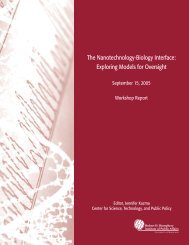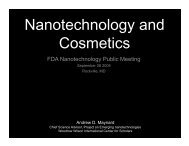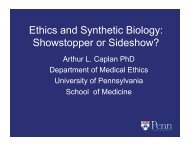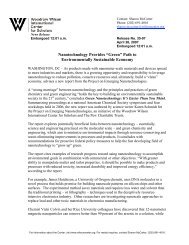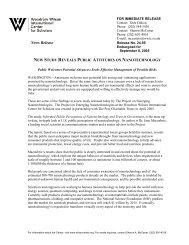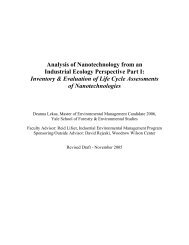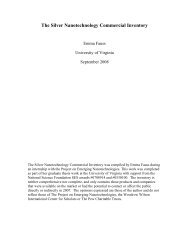nanotechnology oversight - Project on Emerging Nanotechnologies
nanotechnology oversight - Project on Emerging Nanotechnologies
nanotechnology oversight - Project on Emerging Nanotechnologies
Create successful ePaper yourself
Turn your PDF publications into a flip-book with our unique Google optimized e-Paper software.
14<br />
ine whether it can give greater priority to the<br />
development of green <str<strong>on</strong>g>nanotechnology</str<strong>on</strong>g> and<br />
should publicize what it has d<strong>on</strong>e to foster such<br />
development.<br />
5. Evaluate the applicati<strong>on</strong> of<br />
other EPA statutes to <str<strong>on</strong>g>nanotechnology</str<strong>on</strong>g>.<br />
Many EPA laws in additi<strong>on</strong> to TSCA<br />
and FIFRA potentially apply to <str<strong>on</strong>g>nanotechnology</str<strong>on</strong>g>.<br />
The disposal of nanomaterials and products<br />
c<strong>on</strong>taining them comes under the<br />
purview of the Resource C<strong>on</strong>servati<strong>on</strong> and<br />
Recovery Act (RCRA) and the Comprehensive<br />
Envir<strong>on</strong>mental Resp<strong>on</strong>se, Compensati<strong>on</strong>,<br />
and Liability Act (CERCLA) (see<br />
Breggin and Pendergrass, 2007). The Clean<br />
Air and Clean Water Acts will have to be<br />
employed to avoid adverse envir<strong>on</strong>mental<br />
effects from <str<strong>on</strong>g>nanotechnology</str<strong>on</strong>g>, although at the<br />
present time the lack of informati<strong>on</strong> about<br />
effects and the lack of detecti<strong>on</strong> and c<strong>on</strong>trol<br />
technologies make it difficult to use these acts<br />
to deal with <str<strong>on</strong>g>nanotechnology</str<strong>on</strong>g>. EPA should analyze<br />
the short-term possible uses of the air and<br />
water permitting processes to foster disclosure<br />
and to encourage use of good management<br />
practices for nanomaterials.<br />
EPA will need to make many internal<br />
changes to address the envir<strong>on</strong>mental problems<br />
of the 21st century (see Davies 2007). It<br />
will need to better integrate its existing programs<br />
and to develop a forecasting capability<br />
so that it can prepare for problems and develop<br />
strategies for dealing with them. Secti<strong>on</strong> III<br />
c<strong>on</strong>tains a further discussi<strong>on</strong> of this subject.<br />
FOOD AND DRUG ADMINISTRATION<br />
The FDA has broad regulatory authority over<br />
a range of products, including drugs, food,<br />
medical devices, dietary supplements and cosmetics.<br />
Nanomaterials are now in products in<br />
all these categories, and the applicati<strong>on</strong> of<br />
<str<strong>on</strong>g>nanotechnology</str<strong>on</strong>g> to these areas is likely to grow<br />
rapidly in the coming years. There are at least<br />
three major steps that FDA should take to<br />
deal with the increasing use of <str<strong>on</strong>g>nanotechnology</str<strong>on</strong>g><br />
in the products it regulates. Each will<br />
require additi<strong>on</strong>al resources. The three recommendati<strong>on</strong>s<br />
are as follows:<br />
1. Establish criteria for determining<br />
which nanomaterials are<br />
“new” for regulatory purposes.<br />
Similar to TSCA, many important FDA regulatory<br />
authorities are triggered by a substance<br />
being categorized as “new.” FDA needs to<br />
establish criteria and provide guidance to the<br />
industry about when nanomaterials are not<br />
the same as materials that are already listed in<br />
FDA’s GRAS (generally recognized as safe)<br />
food additive and food packaging regulati<strong>on</strong>s<br />
or that have been reviewed under the<br />
Cosmetic Ingredient Review (Taylor 2006, p.<br />
8). The agency criteria clarifying what is<br />
“new” for legal and regulatory purposes “presumably<br />
would include functi<strong>on</strong>al properties<br />
that relate to the likelihood that the safety<br />
profile of the <str<strong>on</strong>g>nanotechnology</str<strong>on</strong>g> versi<strong>on</strong> would<br />
be different from the c<strong>on</strong>venti<strong>on</strong>al <strong>on</strong>e. Such<br />
criteria would be helpful for all categories of<br />
FDA-regulated products as a guide to decisi<strong>on</strong>s<br />
about the need for toxicity testing<br />
bey<strong>on</strong>d what already exists <strong>on</strong> the c<strong>on</strong>venti<strong>on</strong>al<br />
form” (ibid.).<br />
*2. Collect informati<strong>on</strong> <strong>on</strong> safety<br />
testing, forthcoming products and<br />
adverse events. At present, there<br />
are major gaps in FDA’s authority<br />
to require that regulated industries<br />
provide the informati<strong>on</strong> it<br />
needs to assess safety risks.



